Subclass Theria Magnorder Boreoeutheria Scientific name Mesonychia | Infraclass Eutheria Higher classification Laurasiatheria | |
Lower classifications | ||
Prehistoric profiling the mesonychids
Mesonychia ("middle claws") is an extinct taxon of small- to large-sized carnivorous ungulates related to the cetartiodactyls. Mesonychids first appeared in the early Paleocene, went into a sharp decline at the end of the Eocene, and died out entirely when the last genus, Mongolestes, became extinct in the early Oligocene. They resembled wolves, albeit superficially. Early mesonychids probably walked on the flats of their feet (plantigrade), while later ones walked on their toes (digitigrade). These later mesonychids had hooves, one on each toe, with four toes on each foot.
Contents
- Prehistoric profiling the mesonychids
- Mesonychid otter
- Characteristics
- Phylogeny and evolutionary relationships
- Relationship with whales
- References

Mesonychids probably originated in Asia, where the most primitive mesonychid, Yangtanglestes, is known from the early Paleocene. They were also most diverse in Asia, where they occur in all major Paleocene faunas. Since other carnivores, such as the creodonts and condylarths, were either rare or absent in these animal communities, mesonychids most likely dominated the large predator niche in the Paleocene of Asia.
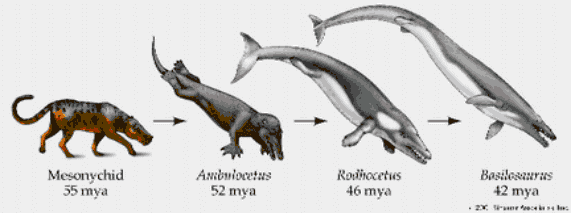
One genus, Dissacus, had successfully spread to Europe and North America by the early Paleocene. Dissacus was a jackal-sized carnivore that has been found all over the Northern Hemisphere, but its daughter genus, Ankalagon, from the early to middle Paleocene of New Mexico, was far larger, growing to the size of a bear. Species of the later genus, Pachyaena, entered North America by the earliest Eocene, where they evolved into huge species surpassing even Ankalagon in size. Mesonychids in North America were by far the largest predatory mammals during the early Paleocene to middle Eocene.
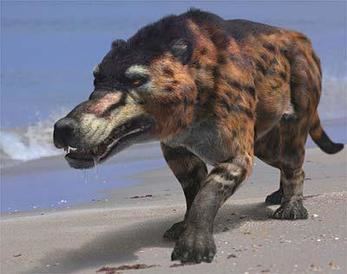
Mesonychid otter
Characteristics
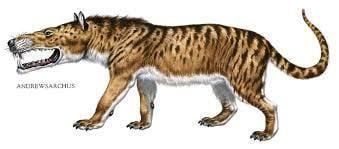
The mesonychids bore a strong, albeit superficial, resemblance to wolves. Early mesonychids had five digits on their feet, which probably rested flat on the ground during walking (plantigrade locomotion), but later mesonychids had four digits that ended in tiny hooves on all of their toes and were increasingly well adapted to running. Like running members of the even-toed ungulates, mesonychids (Pachyaena, for example) walked on their digits (digitigrade locomotion).
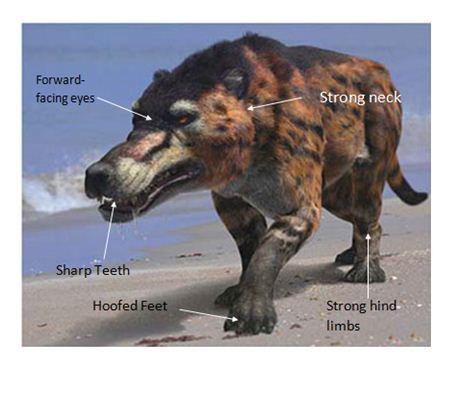
These "wolves on hooves" were probably one of the more important predator groups in the late Paleocene and Eocene ecosystems of Europe (which was an archipelago at the time), Asia (which was an island continent), and North America. Mesonychid dentition consisted of molars modified to generate vertical shear, thin blade-like lower molars, and carnassial notches, but no true carnassials. The molars were laterally compressed and often blunt, and were probably used for shearing meat or crushing bones. Many species are suspected of being fish-eaters, and the largest species are considered to have been scavengers.
Phylogeny and evolutionary relationships
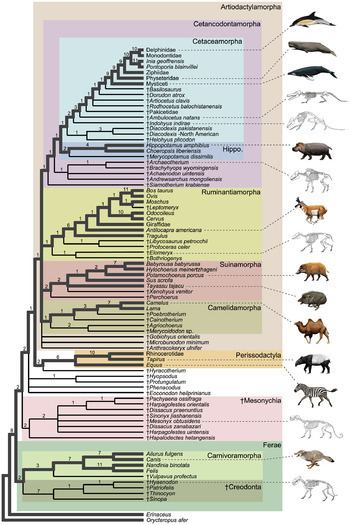
Mesonychians were long considered to be creodonts, but have now been removed from that order and placed in three families (Mesonychidae, Hapalodectidae, and Triisodontidae), either within their own order, Mesonychia, or within the order Condylarthra as part of the cohort or superorder Laurasiatheria. Nearly all mesonychids are, on average, larger than most of the Paleocene and Eocene creodonts and miacoid Carnivorans.
The order is sometimes referred to by its older name "Acreodi". Technically speaking, the term "mesonychid" refers specifically only to the members of the family Mesonychidae, such as the species of the genus Mesonyx. However, as the order is also renamed for Mesonyx, the term "mesonychid" is now used to refer to members of the entire order Mesonychia and the species of other families within it.
A recent study found mesonychians to be basal euungulates most closely related to the "arctocyonids" Mimotricentes, Deuterogonodon and Chriacus. "Triisodontidae" may be paraphyletic.
Relationship with whales
Mesonychids possess unusual triangular molar teeth that are similar to those of Cetacea (whales and dolphins), especially those of the archaeocetes, as well as having similar skull anatomies and other morphologic traits. For this reason, scientists had long believed that mesonychids were the direct ancestor of Cetacea, but the discovery of well-preserved hind limbs of archaic cetaceans, as well as more recent phylogenetic analyses now indicate cetaceans are more closely related to hippopotamids and other artiodactyls than they are to mesonychids, and this result is consistent with many molecular studies.
Most paleontologists now doubt that whales are descended from mesonychids, and instead suggest that they are either descended from, or share a common ancestor with, the anthracotheres, the semiaquatic ancestors of hippos. However, the close grouping of whales with hippopotami in cladistic analyses only surfaces following the deletion of Andrewsarchus, which has often been included within the mesonychids. One possible conclusion is that Andrewsarchus is not a mesonychid, but rather closely allied with hippopotamids. The current uncertainty may, in part, reflect the fragmentary nature of the remains of some crucial fossil taxa, such as Andrewsarchus.
